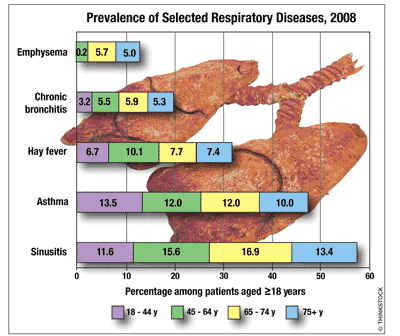US Pharm. 2010;35(7):6.
In 2008, women suffered predominantly from asthma, hay fever, sinusitis, and chronic bronchitis (CB) compared with men, according to the National Center for Health Statistics. Emphysema affected both sexes equally, however. A larger number of non-Hispanic white women suffered from hay fever. Asian adults were less affected by sinusitis in the past year than their African American or white counterparts. Prevalence of asthma, sinusitis, and CB was lower among Hispanic adults than non-Hispanic white adults and non-Hispanic black adults. White non-Hispanic women and black non-Hispanic women were most likely to have sinusitis or CB. The more education an adult had, the less he or she was affected by emphysema or CB; on the other hand, asthma, hay fever, and sinusitis bore no association with education level. The family's economic condition had some differential effect--i.e., poor families had higher percentages of emphysema, asthma, and CB, and families that were not poor had a higher prevalence of hay fever.

Age Groups: The graph shows that combined prevalences of sinusitis, asthma, hay fever, CB, and emphysema were in decreasing order from younger to older age groups. Adults aged 65 to 74 years had the highest prevalence of sinusitis. Among adults aged 65 and over, those insured by Medicaid and Medicare had higher percentages of emphysema, asthma, and CB than those with Medicare only.
Asthma: The burden of asthma, the second most prevalent respiratory disease after sinusitis, has increased over the past two decades. An estimated 7.7% (16.4 million) of noninstitutionalized adults have asthma, in contrast to 9.4% (7 million) of children. Adults and children have generated 10.6 million visits to office-based physicians and 444,000 hospital discharges after an average stay of 3.2 days. An estimated 4.2% of people (12.2 million) had at least 1 asthma attack, and among those who currently have asthma, 55% had at least 1 attack. Attack prevalence decreased with age: 5.2% of children (3.8 million) had an attack, versus 3.9% of adults (8.4 million). Children with food allergy are two- to fourfold more likely to have other related conditions, such as asthma, than children without food allergy. In 2007, 29% of children with food allergy also reported asthma, compared with 12% of children without food allergy. More than 30% of children with food allergy also reported respiratory allergy, versus 9% of children with no food allergy. These statistics are of great importance, as children with coexisting food allergies and asthma are more likely to experience anaphylactic reactions to foods, and they have a greater mortality risk.
To comment on this article, contact rdavidson@uspharmacist.com.






